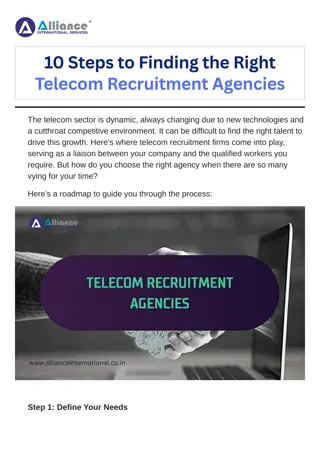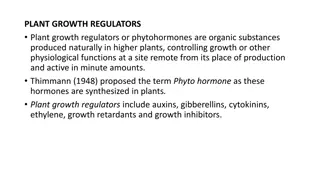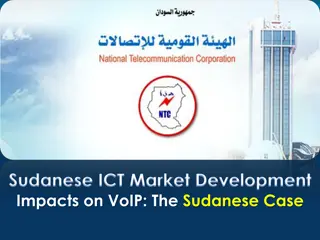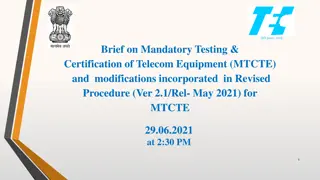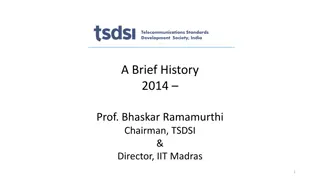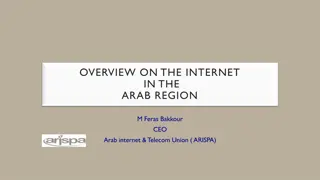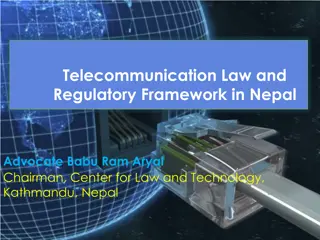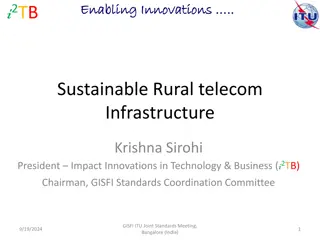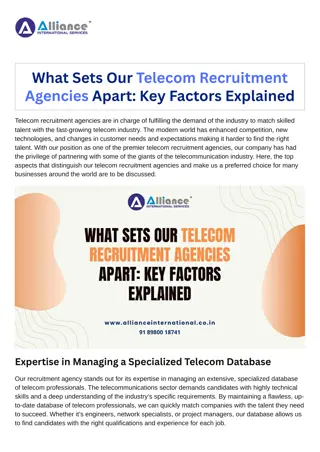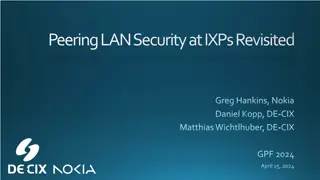Internet Exchange Points (IXPs) for Telecom Regulators
This presentation explores the role of IXPs in solving telecom problems, their success story, goals for regulators, and the impact on Internet and telecom policies. It discusses the growth, models, and success of IXPs in Europe and globally, emphasizing the significance of regulating where necessary and promoting competition in telecom carrier policies.
Download Presentation

Please find below an Image/Link to download the presentation.
The content on the website is provided AS IS for your information and personal use only. It may not be sold, licensed, or shared on other websites without obtaining consent from the author.If you encounter any issues during the download, it is possible that the publisher has removed the file from their server.
You are allowed to download the files provided on this website for personal or commercial use, subject to the condition that they are used lawfully. All files are the property of their respective owners.
The content on the website is provided AS IS for your information and personal use only. It may not be sold, licensed, or shared on other websites without obtaining consent from the author.
E N D
Presentation Transcript
How to think about IXPs if you are a telecom regulator ENOG Yerevan, Armenia October 2016
What this presentation is about IXPs exist to solve certain problems; They are a remarkable success story; They, like the Internet itself, are embedded in an older world of telecommunications, which runs on different infrastructure, economics and ideas. This presentation deals in part with the intersection of the IXP and some of those older concepts and material facts. 2
What the goals are The goals are to encourage regulators to regulate where regulation is needed; To prevent them from regulating where regulation is not needed; To know the difference between the two domains In general, the Internet is working fine; leave it alone In telecom carrier policy, there is seldom enough competition. Regulation and oversight is needed at that level. 3
The success of Internet Exchange Points (IXPs) As recently as 2013 it was said that IXPs had gone unnoticed . From four network access points in 1995 to 86 in North America as of 2013. There are now approximately 350 IXPs, half of which are in the US and Europe according to PCH The total is always subject to some measure of disagreement 4
In Europe Since the 1990s, the European actors (telcos turned ISPs, and new competitors) realized that exchanging their traffic locally brought large cost savings. The not for profit (NFP) model became standard in Europe. DE-CIX, AMS-IX, Ecix These are typically wholly owned by an association; customers provide advice through an advisory board. Most NFPs publish their data, membership, service offerings, & detailed specifications of their infrastructure 5
What is an IXP? AMS-IX defines an ISP as A network infrastructure with the purpose to facilitate the exchange of Internet traffic between Autonomous Systems (ASes) and operating below layer 3. The number of ASes connected should at least be three and there must be a clear an open policy for others to join. The vast majority rely on an Ethernet switching fabric 6
The stunning success of the Internet market An OECD study (2013) showed that the Internet has allowed priced for connectivity to be five orders of magnitude lower than what it is for its TDM equivalent. Stated as the per-minute price for VoIP traffic, the combined cost to caller and recipient is USD 0.0000008 per minute than wholesale service providing comparable functions in TDM markets. This has been achieved with no direct intervention by regulators Why so cheap? Efficiency of packet routing Competition in Internet markets Flexibility of routing arrangements 7
Stunning success, continued The Internet has developed a highly efficient market in connectivity, based on voluntary contractual arrangements. A survey of 142,000 peering arrangements showed that the terms and conditions of the Internet model are so generally agreed on that 99.5% of interconnection agreements are concluded without a written contract. Transaction costs are low Each party agrees that the deal adds value 9
Cause: economics and hands-off regulatory approach The participants are free to decline to do business The ability not to interconnect with those who fail to observe standards disciplines the market Alternative routes are frequently available, and market power of any player is limited; No one in the ISP world is obliged to interconnect. No regulator needs to promote competition at this level of the protocol stack, in these markets. 10
Other European inquiries into the Internet The Body of European Regulators for Electronic Communications (BEREC) issued a report on IXP issues [6 December 2012] as they arose from net neutrality debates BEREC has highlighted the fact that the Internet connectivity market and hosting services have grown from zero to a multi- billion-Euro business in fifteen years on a commercial basis. [Peering and transit] interconnection arrangements developed without any regulatory intervention, although the obligation to negotiate for interconnection applies to IP networks as well. These agreements have been largely outside the scope of activity of National Regulatory Authorities {NRAs}. This appeared justified in particular due to the competitiveness of the transit market on IP backbones. The BEREC report shows considerable understanding of the Internet market and IXPs generally. 11
The TDM world is different Assumptions and facts relevant to the Internet (layer 3) do not apply in the older TDM telephone world (layer 2 and 1). Maintaining the rule of law, open markets and promoting competition is vital, but the way it has been done in telecom markets is conditioned by the older economics and physics of the telephone (TDM) era. So let s look at the strictures imposed by older ways of communicating. 12
Definitions In this context, transport signifies matters pertaining to layers 1 and 2 of the OSI model. transit pertains to OSI layer 3. There is plenty of competition at layer 3, and limited competition at layers 2 and 1, usually 13
Interconnection In the Internet model, no right has been granted by regulatory authorities to acquire interconnection with another party; Proven to be a highly successful model In the world of TDM, a right to interconnection, that is, regulated access to facilities, is often the underpinning of competition in facilities. 14
Intervention and non-intervention The success of the Internet IP market for traffic exchange flowed from a broad policy framework of liberalization of telecom markets that is, in facilities (layers 2 and 1). There has been a close relationship between liberalized telecom policies and the development of the Internet Threats to the Internet include Extending regulatory concepts from the TDM world into the Internet extending the lifetime of old policy goals (e.g. equal geographic access) Treaty-based revenue settlements 15
So how much competition is enough? How many facilities based carriers is optimal (for transport at layers 1 and 2)? What is the number below which we run into problems? Here we pass out of telecom and Internet ideas into the realm of competition policy. We are not talking about the minimum number of interconnecting networks needed for an IXP, which has been set at three. We are talking about transport facilities. 16
Concepts from competition policy It is generally agreed that a monopolist (sole supplier) has incentives to restrict output and raise prices. Competition regulators consider that duopolies (2 suppliers) reach cozy, unspoken accommodations. Coke and Pepsi At 3 suppliers, some real competition begins Competitor #3 is seldom as large as #1 and #2 Price and feature competition begin in earnest 17
How do you measure competition? The US employs the Herfindahl-Hirschmann index. It is arrived at by the sum of the squares of the participants. A score of .25 or more indicates strong concentration. Canada uses Merger Enforcement Guidelines. If the 4 largest players in a market would collectively have >45% of the market, no merger of them would be allowed. Market concentration of 35-45% would put the merger into the caution zone. The definition of the product and geographic market is always decisive. The easier it is to substitute, the easier to get your merger approved. 18
European Approaches to Telecoms Mergers There is no magic number, of mobile operators in a market, stated the European Commissioner Margrethe Vestager in early October 2015 A few years ago, the number three seemed to have magical powers, when the Swiss Competition Commission blocked the merger between the second and the third largest mobile operators in 2010, which would have created a MNO duopoly effective competition in the retail market is the criterion a reduction of the number of players from four-to-three in a national mobile market in the EU can lead to higher prices for consumers but not that it leads to more investment per subscriber, Ms. Vestager said. mergers which reduced operators from 4 to 3 had previously been approved in Ireland, Austria, and Germany 19
What is the problem mergers help to solve? Carriers face enormous costs, thin profit margins, customers dis-intermediating, and new business models that can move the money away from them. The way out is to merge vertical mergers to integrate fixed and mobile businesses to achieve costs synergies and bring new products to market, network sharing agreements, and horizontal mergers between mobile operators to reduce costs and finance new infrastructure investments. The pressure is on regulators to find the best number of carriers, with no fixed answer to the problem. 20
So why at least three transport providers? From the perspective of the IXP, indeed, anyone, the existence of at least 3 transport providers (facilities, circuits) is about as good as it gets. Practical limitations, such as capital investments, tend to limit the number of carriers; More would be desirable, but fewer than 3 produces all the problems associated with unspoken collaboration between 2, and monopoly with 1. 21
Lessons for Policy Makers Liberalized telecommunications policies have supported the success of the Internet, particularly IXPs A hands-off approach has let market participants discipline the market, at the IP layer. Insufficient competition in facilities (layers 1 and 2) keeps transport prices high and retards the spread of the Internet By requiring players to hold government licences, and restricting them, regulators can uphold insufficient competition Finding the right number of transport carriers at layers 1 and 2 is no easy task; countervailing pressures favour mergers of carriers 22
Sources 1 Chatzis, N., Feldmann, A., Smaragdis G., Willinger, W. 2013 On the importance of Internet exchange points for today s Internet ecosystem. Available at http://arxiv.org/abs/1307.5264 Haitham El-Nakhal, Implementation and Management of Internet Exchange Points (IXP), Feb 2014 ITU-T SG3RG-AFR Reg. and Econ. Forum NSF Implementation Plan for Interagency Interim NREN, Aiken, Braun, Ford, Claffy. May 1992 OECD Digital Economy Papers, No.207. Internet Traffic Exchange: Market Developments and Policy Challenges, Dennis Weller, Bill Woodcock, 2013 OECD Digital Economy Papers No.232, International Cables, Gateways, Backhaul and International Exchange Points , Rudolph van der Berg, 2013 23
Sources 2 https://ec.europa.eu/commission/2014- 2019/vestager/announcements/competition-telecom- markets_en https://www.competitionpolicyinternational.com/magic- numbers-and-merger-control-in-the-telecommunications- sector/ http://www.wsj.com/articles/eu-antitrust-chief-cautions- against-4-to-3-mobile-telecom-mergers-1443789301 http://www.nortonrosefulbright.com/files/gcr-the- european-antitrust-review-2016-uk-telecoms-130445.pdf http://eur-lex.europa.eu/legal- content/EN/TXT/HTML/?uri=CELEX:32004R0139&from=EN Draft BEREC Report on Oligopoly Analysis and Regulation 24
Acknowledgements The author wishes to thank Geoff Huston of APNIC, Mike Leber of Hurricane Electric, John Curran of ARIN, and Konrad von Finckenstein, former Director of Canada s Bureau of Competition Policy, and Gernot Kofler, of the Bureau of Competition Policy, for clarifying conversions. All mistakes of interpretation are my own - TMD 25



